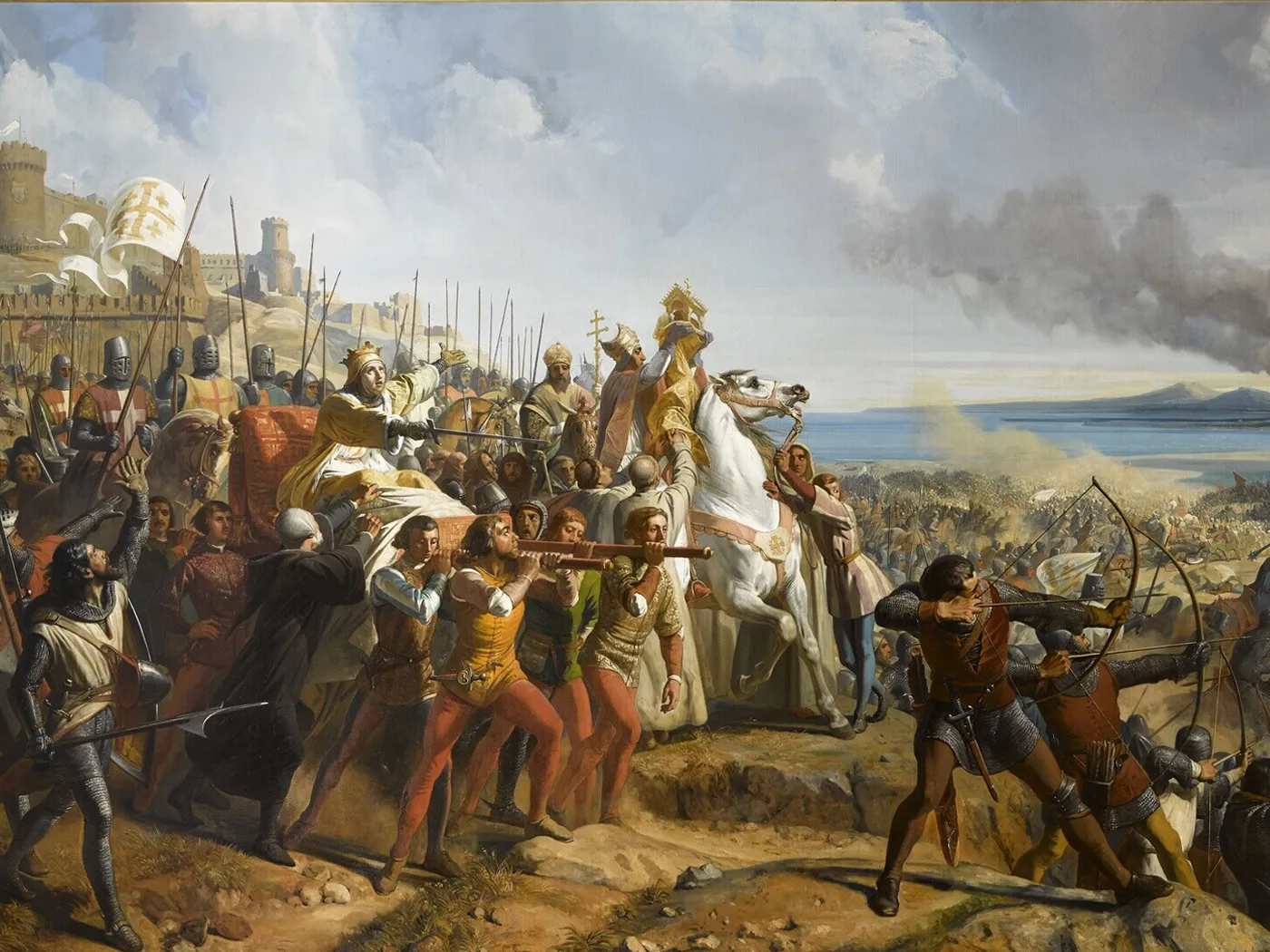
The History of the Crusades and the Religious Conflicts in the Middle Ages
The Crusades, a series of religiously motivated military campaigns sanctioned by the Catholic Church during the Middle Ages, remain a pivotal event in world history. Their impact reverberates through centuries, shaping relationships between Christians, Muslims, and Jews, and leaving a complex legacy of conflict and cooperation that continues to influence our world today. This in-depth exploration delves into the history of the Crusades, analyzing their causes, consequences, and enduring relevance.
I. The Genesis of the Crusades: A Confluence of Factors
The Crusades weren’t a singular event but a multifaceted phenomenon spanning nearly two centuries. Their origins are rooted in a confluence of factors:
The Rise of Islam: The rapid expansion of the Islamic caliphate in the 7th and 8th centuries significantly altered the political and religious landscape of the Middle East and North Africa. The loss of territories once under Byzantine (Eastern Roman) rule, including the Holy Land, fueled Christian anxieties. The perceived threat of Islam, coupled with a desire to reclaim sacred sites, formed a powerful impetus for the Crusades.
The Weakening Byzantine Empire: The Byzantine Empire, the eastern continuation of the Roman Empire, faced increasing internal and external pressures. Its power waned, and it struggled to defend its remaining territories against external threats, including the Seljuk Turks, who had captured much of Anatolia and posed a threat to Constantinople. Emperor Alexios I Komnenos appealed to the West for military assistance, a request that Pope Urban II would skillfully leverage.
The Papacy’s Political Ambitions: The papacy, eager to consolidate its power and influence within Europe, saw the Crusades as a means to achieve several objectives. It aimed to reassert its authority over the fragmented Western Church, redirect aggressive energies of European nobles towards a common cause, and establish a stronger presence in the East. The promise of spiritual rewards, including remission of sins, proved highly effective in mobilizing support for the expeditions.
Economic and Social Factors: The Crusades were not solely driven by religious zeal. Economic opportunities, including the acquisition of land, wealth, and trade routes, significantly attracted many participants. Land-hungry nobles, ambitious merchants, and impoverished peasants all sought to improve their fortunes through participation. The promise of adventure and the chance to escape the constraints of feudal society also played a role.
Religious Zealotry: While economic and political motivations were undeniable, a genuine religious fervor fueled the Crusades. The belief in the sanctity of the Holy Land, the desire to defend Christendom against perceived enemies, and the promise of salvation played a significant role in motivating participants. The rhetoric employed by Pope Urban II at Clermont in 1095 skillfully combined these religious and worldly aspirations.
II. The First Crusade (1096-1099): Conquest and Carnage
Pope Urban II’s call for a Crusade in 1095 sparked an unprecedented response. The First Crusade, though disorganized initially, ultimately resulted in the recapture of Jerusalem and the establishment of Crusader states.
The People’s Crusade: Before the main armies departed, a series of “People’s Crusades” set off, led by charismatic preachers like Peter the Hermit. These largely unorganized groups suffered devastating losses, becoming victims of violence and disease along their journey. Their failures highlighted the organizational challenges of such a vast undertaking.
The Princes’ Crusade: The main body of the First Crusade comprised a force of knights and soldiers from various European kingdoms, led by prominent nobles like Godfrey of Bouillon, Raymond of Toulouse, Bohemond of Taranto, and Robert of Normandy. Their journey was a long and arduous one, marked by sieges, battles, and negotiations.
The Siege of Antioch: The siege of Antioch, a crucial Byzantine city, lasted for months. The Crusaders’ eventual victory, partially aided by a strategic betrayal, involved considerable bloodshed and brutality. This laid the groundwork for their eventual success in Jerusalem.
The Capture of Jerusalem: After taking Antioch, the Crusaders pressed southward. In July 1099, Jerusalem fell after a grueling siege. The city’s capture was followed by a horrific massacre of its Muslim and Jewish inhabitants, an event that casts a dark shadow over the Crusade’s supposed religious mission.
The Establishment of Crusader States: Following the conquest of Jerusalem, the Crusaders established four major Crusader states: the Kingdom of Jerusalem, the County of Tripoli, the Principality of Antioch, and the County of Edessa. These states, however, were constantly under pressure from Muslim forces seeking to reclaim the lost territories.
III. The Crusader States (1099-1187): A Precarious Existence
The Crusader states, despite their initial successes, faced numerous challenges:
Internal Conflicts: The Crusader states were not unified entities. Internal conflicts, power struggles, and rivalries among the different noble houses weakened their ability to defend against external threats.
Muslim Resistance: The initial Muslim response to the First Crusade was fragmented. However, over time, powerful Muslim leaders emerged who successfully coordinated efforts to counter the Crusaders.
Zengis’ Threat and the Second Crusade: The fall of Edessa in 1144 to the Seljuk leader Zengi marked a turning point. This prompted the Second Crusade (1147-1149), largely ineffective and ending in failure, highlighting the challenges faced by the Crusader armies in coordinating their efforts and dealing with the sophisticated military tactics of their opponents. The Second Crusade’s failure demonstrated the growing military strength of the unified Muslim forces.
Saladin’s Rise: The emergence of Saladin, the Kurdish sultan of Egypt and Syria, proved to be a significant turning point. Saladin’s military prowess and skillful diplomacy unified much of the Muslim world against the Crusaders.
IV. Saladin, the Third Crusade, and the Decline of Crusader Power (1187-1291)
Saladin’s victory at the Battle of Hattin in 1187, resulting in the recapture of Jerusalem, marked a decisive shift in the balance of power. This precipitated the Third Crusade.
The Third Crusade (1189-1192): Launched by powerful European monarchs, including Richard I (“the Lionheart”) of England, Philip II of France, and Frederick I Barbarossa of the Holy Roman Empire, the Third Crusade achieved some successes, regaining coastal cities like Acre. However, it failed to retake Jerusalem, and the Crusader states faced ongoing attrition.
The Fourth Crusade (1202-1204): This Crusade, infamous for its diversion to Constantinople, resulted in the sack of the Byzantine capital. This act drastically weakened the Byzantine Empire and further fractured relations between the East and West. The Fourth Crusade is often seen as an example of the Crusaders’ ambitions exceeding their religious goals.
The Later Crusades: Subsequent Crusades were less successful. The Children’s Crusade (1212), a tragic and ultimately futile endeavor, further exposed the growing vulnerability of the Crusader states. The fall of Acre in 1291, the last major Crusader stronghold, marked the definitive end of the Crusader presence in the Holy Land.
V. The Legacy of the Crusades: Long-Term Impacts
The Crusades’ legacy extends far beyond the immediate military outcomes. Their long-term consequences shaped the political, religious, and cultural landscapes of Europe and the Middle East.
The Impact on the Middle East: The Crusades resulted in significant destruction and loss of life. The prolonged conflicts disrupted existing trade routes, destabilized political structures, and contributed to centuries of mistrust between Christians and Muslims.
The Impact on Europe: The Crusades spurred significant changes in Europe. They contributed to the growth of towns and cities, stimulated trade, and fostered the development of new military technologies and tactics. The Crusades also indirectly fueled intellectual and cultural exchanges, leading to the dissemination of knowledge and ideas from the East to the West.
The Development of Religious Intolerance: The Crusades exacerbated existing religious prejudices and intolerance, contributing to a climate of suspicion and hostility between different faith groups. The violence perpetrated during the Crusades is a constant reminder of the dangers of religious extremism and the importance of promoting interfaith dialogue and understanding.
The Rise of Nation-States: The Crusades contributed to the gradual development of centralized nation-states in Europe. The collaborative effort required for the Crusades strengthened national identities and fostered a sense of shared purpose among different social groups.
Historiography and Modern Interpretations: The interpretation of the Crusades has evolved significantly over time. Modern scholarship emphasizes the complexities of the events, acknowledging the diverse motives and perspectives of participants from different faiths and social backgrounds. The Crusades are now examined not only as military campaigns but also as cultural, social, and economic phenomena with wide-ranging consequences.
VI. The Crusades and Interfaith Relations: A Complex Legacy
The Crusades profoundly impacted interfaith relations, leaving a complex legacy of both conflict and cooperation.
Violence and Intolerance: The violence associated with the Crusades fueled deep-seated mistrust and antagonism between Christians and Muslims. The massacres of civilians in Jerusalem and other cities, alongside the persecution of Jewish communities, left an enduring scar on interfaith relations.
Cultural Exchange: Despite the conflicts, the Crusades also facilitated some degree of cultural exchange. The Crusaders encountered new ideas, technologies, and cultural practices in the East, which were subsequently introduced to Europe. This interaction, although often tainted by violence and prejudice, nevertheless contributed to the enrichment of European culture.
The Ongoing Debate: The Crusades continue to be a subject of intense debate and interpretation. Scholarly understanding has moved away from simplistic narratives of “good versus evil” to a more nuanced examination of the complex motives and consequences of these events.
The Relevance to Modern Interfaith Relations: Understanding the history of the Crusades is crucial for fostering more constructive interfaith relations today. The events serve as a cautionary tale of the dangers of religious extremism, intolerance, and the destructive potential of religiously motivated violence. Learning from the mistakes of the past is essential for building a more peaceful and harmonious future.
VII. The Enduring Relevance of the Crusades in the 21st Century
The Crusades remain remarkably relevant in the 21st century. Their legacy continues to shape perceptions and influence actions.
The Use and Misuse of History: The Crusades have been invoked both legitimately and illegitimately to justify political agendas, military interventions, and claims of historical righteousness. It’s crucial to critically examine how historical events like the Crusades are used and misused in contemporary political discourse.
The Importance of Historical Understanding: A thorough understanding of the Crusades is indispensable for fostering meaningful interfaith dialogue and promoting religious tolerance. By acknowledging the complex and often contradictory aspects of this historical period, we can better address contemporary challenges related to religious conflict and peaceful coexistence.
Lessons for the Future: The Crusades provide valuable lessons for the present. The events serve as a constant reminder of the importance of critical thinking, historical awareness, and promoting peaceful conflict resolution. By analyzing the causes and consequences of the Crusades, we can develop strategies to prevent future conflicts fueled by religious or ideological differences.
In conclusion, the Crusades represent a pivotal era in history, one characterized by religious fervor, political ambition, military conflict, and significant cultural exchange. Their impact continues to resonate today, underscoring the need for a nuanced understanding of the past to promote a more tolerant and peaceful future. The events of the Crusades serve as a cautionary tale, reminding us of the devastating consequences of religious intolerance and the enduring importance of fostering mutual respect and understanding among diverse religious communities. The legacy of the Crusades demands careful study and thoughtful reflection to guide our actions and interactions in the present and for generations to come.


